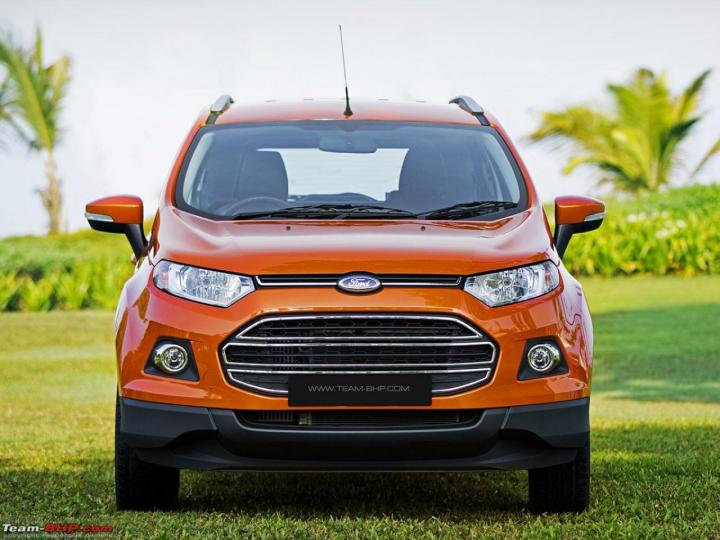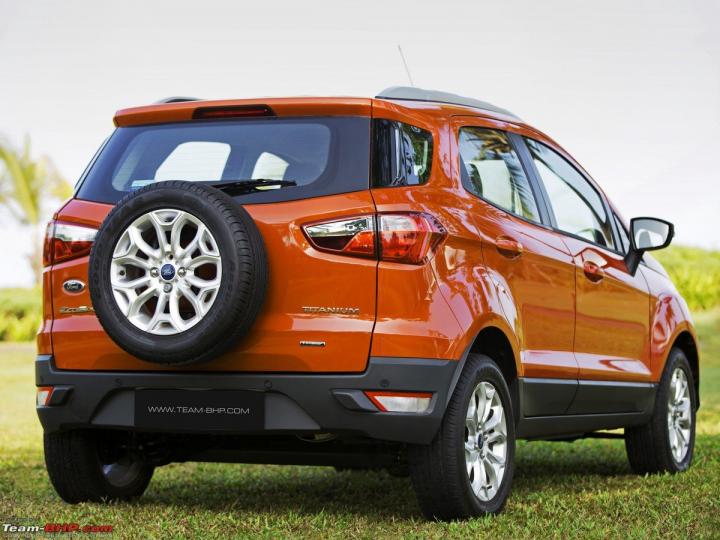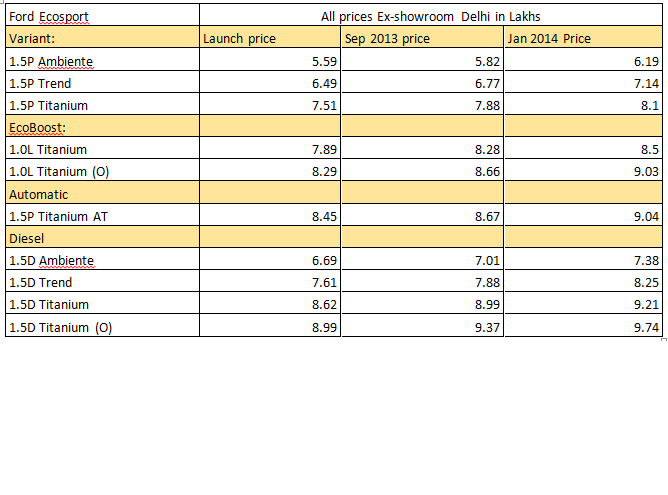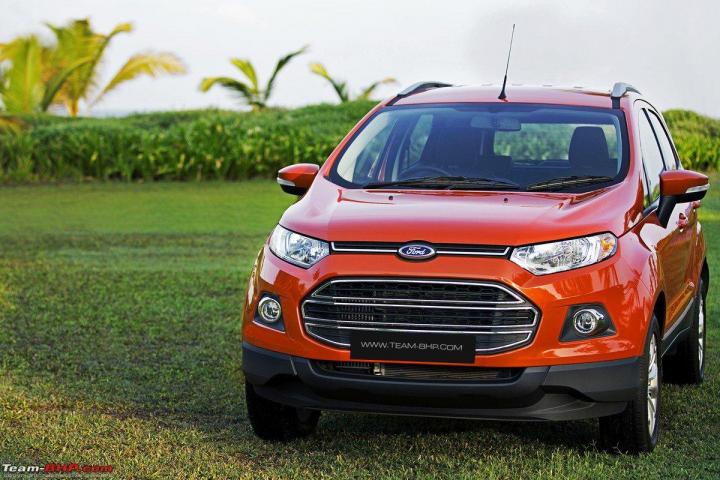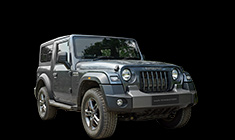News
Ford to work on reducing EcoSport waiting period
Ford launched the EcoSport compact SUV in June 2013, it was an instant hit. However, with a limited production capacity, and supplier constraints, the company could not supply enough cars to match the demand. This resulted in long waiting periods. Even today, certain variants still command a waiting period of 6 months or so. Now however, this waiting period is expected to come down as Ford is planning to add a third shift at its Maraimalainagar plant for production of the vehicle.
Lower variants of the EcoSport, the 1.5 Ambiente in particular, have been the worst hit due to the short supply. It is rumoured that Ford is limiting the supply of these variants since they are not very profitable for it. The company claims that the drastic devaluation of the Indian Rupee from 45 to the US Dollar to 60, has been one of the reasons why it is under pressure to limit the supply of these variants.
After two price hikes since its launch, the EcoSport's base and mid variants now cost about Rs. 65,000 more. Ford has managed to sell 63,598 units of the compact SUV till date.
Source: Autocar India
News
Rumour: North America to get Thai-made Ford EcoSport
Ford is expected to launch the EcoSport compact SUV in North American markets in the first half of 2016. However, for America, the automaker is likely to source the vehicle from its Thailand unit instead of India.
A report by Economic Times claims that Ford Thailand is likely to be offered a chance to supply 55,000-70,000 units of a facelifted version of the EcoSport to North American markets including USA and Canada. It is said that the Thai-built cars have better noise, vibration and harshness levels than the ones built in India, making them more suitable for demanding markets in North America. Additionally, Ford wants better capacity utilisation at its Thailand plant.
India is a major export hub for Ford. The company's Indian factory built more than 1.3 lakh vehicles in FY 2013-14, out of which about 35% were exported. However, the high export numbers meant that the domestic customers, especially for the EcoSport, had to wait for long periods for their vehicles to be delivered. The news that Ford India will not be exporting the EcoSport to North America will be welcomed by Indian customers. India will also get the facelifted version of the car in 2016.
For Ford India however, this is a setback. An export order would have helped it improve capacity utilisation at its Chennai plant and achieve breakeven sooner than expected.
News
Ford reopens bookings for EcoSport
Ford India has announced that it has re-opened bookings for the EcoSport compact SUV. The company claims that it has delivered 50,000 units of the EcoSport and considerably reduced its waiting period.
The EcoSport is Ford's best-selling car in India. When it was launched in June 2013, it generated a lot of interest among buyers. Such was the demand that it managed to bag 30,000 bookings in just 17 days of its launch. The company's factory however, had a relatively small production capacity and could not match the demand. This resulted in long waiting lists (8-12 months in the case of some variants), following which Ford was forced to stop accepting any more bookings.
While it was unable to deliver cars, the company raised the price of the EcoSport more than once, without offering price protection to its customers. The company had even asked customers to opt for other models on which it was offering discounts. As an alternative, it was offering a full refund of the booking amount upon cancellation of bookings.
News
Ford gives EcoSport optional DRLs in India
Ford India has added LED daytime running lights (DRLs) to the list of optional equipment available on the EcoSport SUV.
DRLs are among the most popular accessories at the moment and many customers are opting for aftermarket version for their cars. However, the fitment of such products might require wires to be spliced which would void the warranty. This has prompted Ford to offer "Signature headlamps" on the EcoSport which come with integrated LED DRLs. These lights are available on the EcoSport in international markets. The cost of Signature headlamps is Rs. 14,000 and that includes the wiring required for the DRLs.
Another accessory that Ford is planning to introduce on the India-spec EcoSport is a sunroof. Like DRLs, the Ecosport comes with this feature in international markets.
The EcoSport is one of the most popular SUVs in India and commands long delivery periods.
News
Indian-made Ford EcoSport to be tweaked for Europe
Ford will start selling the India-built EcoSport in Europe starting June 2014. However, the Europe-bound cars will be different from those made for the domestic market.
The company has made changes to as many as 300 parts of the car.
One of the most important changes is a stronger body structure. This is not surprising, since the car had achieved a 4 star Euro NCAP rating when it was crash-tested in November 2013. The stronger body structure is expected to help the EcoSport score 5 Stars in European crash-tests.
While it is obvious that Ford is selling the EcoSport with a weaker body in India to keep the price low, the maturing Indian customer may not appreciate such a step.
Like India, the Europe-spec EcoSport will not feature four-wheel drive.
The EcoSport will be first introduced in Germany, UK, Austria and Switzerland after which, the company will begin sales in the rest of Europe. The car will be aimed at urban professionals aged between 30 and 45 years.
Source: europe.autonews.com
News
Ford plans round the clock production at Chennai
If a report from the Economic Times is to be believed, Ford is planning to make its Chennai facility produce vehicles round the clock. This plan is owing to the high demand for the Ford EcoSport; both local and international. The plant is expected to start off with 24x7 manufacturing by the second half of 2014. In the middle of a downturn for the Indian car industry, this decision by Ford is quite surprising, but inevitable.
If vendors can supply the necessary components on time, Ford plans to rake up the production capacity to 2,00,000 cars on a later date for which the Chennai facility will need to run at full steam, 24x7. As of now, Ford has set it's target to 1,60,000 units in 2014. As of date, Ford manufactures 350 units of the EcoSport / day; and the plan is to increase this number to 450 by June 2014. Come October 2014, Ford will produce 600 units of the EcoSport / day to meet the demand from international markets. By this time, the overall production capacity including all Ford vehicles will be around 750-850 units / day. Even Hyundai operates in three shifts from it's facility in Chennai.
Extra long waiting periods for the EcoSport are expected to go down once this 24x7 production begins. Since the launch, the EcoSport gathered bookings well over 60,000 out of which only 35,000 have been delivered by Ford, by January '14.
News
Ford EcoSport prices hiked. AGAIN!
With the coming of January 2014, Ford has hiked the price of the EcoSport crossover. This is the second time the manufacturer has done so since the car was launched in June 2013, the first being in September.
We had earlier reported that customers could have to wait for a long time before their EcoSports are delivered. The company accepted 60,000 bookings for the car, but has managed to deliver only around half the number. Many of these bookings have been placed around the date the car was launched. Ford has not offered any price protection to its customers, which means that they will have to pay more to the extent of the price hike, which has, understandably, made them unhappy. The company has offered to refund full booking amount without deducting cancellation charges to customers who cancel their bookings for the EcoSport. Additionally, the company is offering EcoSport customers the option of buying their other products with benefits up to Rs. 10,000.
The table shows the prices of all the variants of the EcoSport. Some observations made:
- The range of the price hike across all variants since the launch, is from Rs. 59,000 to Rs. 75,000.
- The average price hike across all variants in September 2013 was Rs. 32,000.
- The average price hike across all variants between launch and January 2014 is Rs. 64,000.
- The Titanium (O) variant sees the highest hike – Rs. 74,000 for the EcoBoost and Rs. 75,000 for the diesel.
- The January 2014 price hike of the base variant, Trend, is the same as that of the top-end Titanium (O) variant.
- Some of the variants of the EcoSport are now priced at par with some variants of the new Honda City and very close to the much larger XUV500 W4.
One of the reasons Ford has been unable to supply enough EcoSports to match the demand is its limited monthly production capacity. Additionally, the company has been exporting the EcoSport to various countries across the world, which could have resulted in the domestic market being neglected. The inability to match the demand for the EcoSport and the steep price hikes could see customers going to other manufacturers.
News
Ford EcoSport buyers in for a long wait
In what comes as a big disappointment to prospective owners, Ford has indicated that the delivery period for the EcoSport crossover could be lengthened. Those who had booked the car in June 2013, had been given a March 2014 delivery date, but now they could have to wait till July or even August.
Ford claims that the unexpected demand for the car is the reason for the delay in deliveries. With its inability to meet the demand, the company has asked its customers to opt for other models from its line-up like the Figo, Classic, Fiesta and Endeavour. Additionally, benefits of up to Rs. 10,000 are being offered on them. In the event of the booking of an EcoSport being cancelled, Ford is offering a full refund of the booking amount, without the deduction of cancellation charges.
Ford had launched ten variants of the EcoSport, priced between Rs, 5.59 lakh and Rs. 8.99 lakh (ex-showroom Delhi). Customers could choose between a 1.0-litre petrol, a 1.5-litre petrol and a 1.5-litre diesel engine. The company raised prices of all its models in September.
With another hike in prices due in January 2014, customers will be required to pay more to that extent, which has left most of them unhappy. The company stopped accepting bookings for the EcoSport after the number crossed 60,000. So far, only around 30,000 cars have been delivered. 972 units of the EcoSport diesel were recalled within two weeks of the car’s launch, to rectify a fault with their glow plugs.
Source: Business Line
News
Ford EcoSport given 4 stars by Euro NCAP, 5 by Latin NCAP
European New Car Assessment Programme (Euro NCAP) has given the Ford EcoSport a 4 star rating in its crash tests. An analysis shows that the Indian-built crossover scored 93% for adult occupant safety, 77% for child occupant safety, 55% for safety assist and 58% for pedestrian safety. It is clear that the car performed well in occupant safety, but did not do well in pedestrian safety. The lack of a speed limitation device and seatbelt reminder system for the rear passengers, pulled the EcoSport's score further down.
It should be noted that the Fiesta, which uses the same platform as the EcoSport, walked away with a 5 star rating. Tested in 2012, the Fiesta scored 91% for adult occupant safety, 86% for child occupant safety, 65% for pedestrian safety and 71% for safety assist.
In March 2013, Latin NCAP (for South America), had awarded the crossover a similar rating. The crossover managed a score of 13.64 out of 16 for adult occupant safety and 31 / 49 for child occupant safety. Ford responded by equipping the Brazilian-built EcoSport with seatbelt reminders that meet Latin NCAP requirements. In November, Latin NCAP tested the car again and awarded it 14.64 / 17 in adult occupant safety. This has helped the EcoSport secure a 5 star rating.
- Tags:
- Indian
- International
- NCAP
- EcoSport
News
Ford India dealers stop bookings for select EcoSport variants
Unable to service the stiff demand for the Ford EcoSport, many Indian dealers of the American car maker have temporarily stopped accepting bookings for the crossover. While some Ford dealers aren't taking fresh bookings for the base-diesel model of the crossover, other dealers have stopped accepting bookings for the mid and top end variants of the EcoSport.
While the 1.5 liter petrol engined model of the EcoSport seems unaffected by high demand, bookings of the top-end EcoBoost engined model are also said to be stopped at certain dealers. Waiting periods for the EcoSport range from a few weeks at certain parts of India, to as much as 8-12 months (for select variants) in most other parts of the country.
The stoppage in bookings at the dealer level seems to be prompted by the car maker, who is seeking to gain control over the growing waiting periods. The stoppage of bookings is at odds with Ford India Managing Director, Mr Joginder Singh's statements. Mr Singh, in an May 2013 interview to BusinessStandard, had this to say,
We are not only ready for the domestic market but are geared up for the export market as well. Chennai will be the source for domestic and exports. If the demand goes through the roof, which we think it will, then we are geared up for that too.
The crossover is available with three engine and two transmission options. A 1.5 liter naturally aspirated petrol unit, a 1 liter turbo petrol unit and a 1.5 liter turbo diesel motor are the three engine options on the EcoSport. A 5 speed manual gearbox is standard on all three engines while the 1.5 liter petrol motor gets a dual clutch 6 speed automatic gearbox as an option.
The EcoSport is sold in 10 different variants, spanning across the 3 engine options. The crossover is built at Ford India's Maramalainagar factory, off Chennai, with a localization level of about 70%. Ford India also exports the EcoSport to markets across the globe. Eventually, the EcoSport will be Ford India's biggest export driver, taking over the mantle from the Figo hatchback.
The Ford EcoSport is manufactured across three locations, Brazil, China and India, with the fourth location, Thailand, to begin production soon. While the Brazilian facility will cater to Latin American markets, the Chinese facility will cater largely to local demand. India will be an export hub catering to Middle Eastern and European markets while the Thai facility will focus on the Far East.
Source Profit.NDTV
Pages





